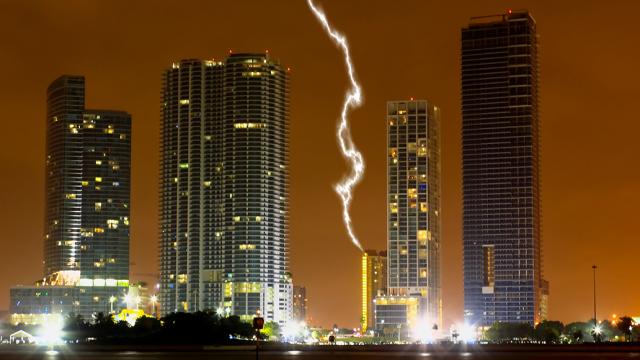The standard advice authorities offer when lightning starts crackling across the sky is for people to take shelter inside buildings. Through lightning rods affixed to the roof, electrical wiring, and plumbing that can direct the electricity away from occupants and into the ground, substantial structures offer protection.
But what is there to protect the buildings themselves from more than five billion Joules of energy in a typical lightning strike, which is enough juice to toast 100,000 bread slices? The problem is no small one — the Empire State Building in New York City gets hit by lightning an average of 25 times a year. And Underwriters Laboratories reports that lightning accounts for more than $1 billion in building damage in the US every year.
Many buildings install lightning protection systems to direct lightning’s energy into the ground, which the Insurance Institute for Business and Home Safety says are highly effective at preventing fires and destructive electrical surges after a strike.
Now researchers say there might be a next-generation protective system that prevents lightning from hitting a building at all. Their secret weapon? High-intensity lasers.
The Laser War Against Lightning
University of Arizona and University of Central Florida optical scientists say such beams of high-energy focused light can strip electrons from molecules in the air. This ionizes the molecules and leaves behind a plasma channel, which a lightning strike would see as a path of least resistance. This would attract the lightning and provide a route that it would follow down into the ground.
Their building protection idea sprouted from a Department of Defence project intended to harness lasers for advanced, long-range airborne detection systems.
They realised that for either the detection or lightning protection system to work, they’d need to overcome a major obstacle to firing high-intensity lasers into the atmosphere — such beams currently lose power after only a few inches because of atmospheric turbulence and water droplets suspended in air.
Their solution was to embed the high-intensity laser in the middle of a beam of lower intensity they call the dress beam. This creates a virtual filament in which the dress beam feeds power into the high-intensity center, helping it stay focused and overcome objects that would otherwise cause it to scatter.

The filament and “dress” for the laser design, courtesy University of Arizona.
“Think of two aeroplanes flying together, a small fighter jet accompanied by a large tanker,” said Maik Scheller, a University of Arizona assistant research professor of optical sciences, in a statement. “Just like the large plane refuels the fighter jet in flight and greatly extends its range, our primary, high-intensity laser pulse is accompanied by a second laser pulse — the dress beam — which provides a constant energy supply to compensate for the energy loss of the primary laser beam as it travels farther from its source.”
Their work, which was recently published in the journal Nature Photonics, extended the high-intensity laser’s range from 10 inches to seven feet in the lab. Using models to scale up their innovation, they believe they could extend it to 165 feet in real-world conditions.
Lead picture: gary718/Shutterstock.
This post originally appeared on Txchnologist.
Txchnologist is a digital magazine presented by GE that explores the wider world of science, technology and innovation.
Michael Keller is Managing Editor of Txchnologist. His science, technology, and international reporting work has appeared online and in newspapers, magazines and books, including the graphic novel Charles Darwin’s On the Origin of Species.
